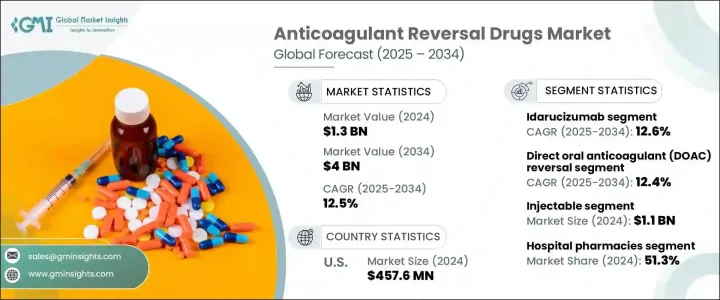
세계의 항응고제 역전제 시장은 2024년에 13억 달러로 평가되었으며, 2025년부터 2034년에 걸쳐 CAGR 12.5%로 성장할 것으로 예측됩니다.
이러한 시장 확대는 주로 항응고제 사용 증가와 출혈 합병증 발생률 증가로 인해 효과적인 역전제의 필요성이 강조되고 있기 때문입니다. 심부정맥 혈전증, 폐색전증, 심방세동과 같은 심혈관 질환 및 혈전성 질환이 지속적으로 증가함에 따라 응급 상황에서 항응고 효과를 빠르게 역전시킬 수 있는 약물에 대한 수요도 증가하고 있습니다. 직접 경구용 항응고제(DOAC), 와파린, 헤파린에 대한 새로운 역전제의 도입으로 환자와 의료진 모두에게 더 안정적이고 접근하기 쉬운 치료 환경이 변화하고 있습니다.

전 세계적으로 인구 고령화와 만성 질환의 유병률 증가로 인해 항응고제 사용이 크게 증가했습니다. 장기 항응고 요법은 이제 다양한 심혈관 및 혈전 질환에 대한 일반적인 치료법입니다. 그러나 이러한 치료는 출혈 합병증의 위험을 증가시키므로 신뢰할 수 있는 역전 옵션이 절실히 필요합니다. 항응고제 역전제는 이러한 문제를 해결하여 중증 출혈이나 수술과 같은 부작용이 발생하는 동안 환자의 안전을 보장합니다. 의료 기술의 발전으로 보다 효과적이고 신속한 역전 치료법이 개발됨에 따라 임상 및 병원 환경에서 이러한 치료법이 더 널리 채택됨에 따라 시장은 더욱 성장할 것으로 예상됩니다.
| 시장 범위 | |
|---|---|
| 시작 연도 | 2024년 |
| 예측 연도 | 2025-2034년 |
| 시작 금액 | 13억 달러 |
| 예측 금액 | 40억 달러 |
| CAGR | 12.5% |
시장은 안덱사넷 알파, 피토나디온(비타민 K), 프로트롬빈 복합 농축물, 이다루시주맙, 프로타민 및 기타 관련 제품을 포함하는 제품 유형별로 분류됩니다. 2024년 4억 4,350만 달러에 달하는 이다루시주맙은 다비가트란의 효과를 역전시키는 역할에 힘입어 예측 기간 동안 12.6%의 연평균 성장률(CAGR)을 기록할 것으로 예상됩니다. 다비가트란은 특히 심방세동 및 심부정맥 혈전증과 같은 질환을 관리하기 위해 널리 사용되는 DOAC입니다.
투여 경로에 따라 시장은 주사제와 경구제로 나뉩니다. 주사제 부문은 2024년 11억 달러 규모로 시장을 주도하고 있으며, 위급한 상황에서 신속하고 효과적인 작용을 위해 주사제가 선호되고 있습니다. 이러한 속효성 약물은 즉각적인 개입이 중요한 중증 출혈이나 긴급 수술과 같은 응급 상황에서 항응고를 역전시키는 데 필수적입니다.
미국의 항응고제 역전제 시장은 2024년에 4억 5,760만 달러에 달할 것으로 예상됩니다. 심혈관 및 신장 질환과 같이 항응고 치료가 필요한 만성 질환의 발병률이 증가함에 따라 항응고제와 역전제에 대한 수요가 증가하고 있습니다. 또한, 보다 안전한 항응고제 및 역전 요법의 개발을 장려하는 규제 지원은 지속적인 성장세를 보이고 있는 미국 시장을 더욱 활성화하고 있습니다. 혈전색전증 및 출혈 장애의 위험에 노출된 노인 인구가 많고 증가함에 따라 미국 시장은 새로운 역전제 및 치료법이 도입되고 임상 진료에 통합됨에 따라 지속적인 수요가 있을 것으로 예상됩니다.
The Global Anticoagulant Reversal Drugs Market, valued at USD 1.3 billion in 2024, is set to experience impressive growth, projected at a CAGR of 12.5% from 2025 to 2034. This market expansion is largely driven by the growing usage of anticoagulants and the rising incidence of bleeding complications, which emphasize the need for effective reversal agents. As cardiovascular diseases and thrombotic conditions like deep vein thrombosis, pulmonary embolism, and atrial fibrillation continue to increase, so does the demand for drugs that can quickly reverse anticoagulation effects in emergency situations. With the introduction of novel reversal agents for direct oral anticoagulants (DOACs), warfarin, and heparin, the landscape is transforming, making treatment more reliable and accessible for both patients and healthcare providers.

Aging populations worldwide, coupled with an increasing prevalence of chronic conditions, have significantly amplified the use of anticoagulants. Long-term anticoagulation therapy is now a common treatment for a variety of cardiovascular and thrombotic diseases. However, these treatments increase the risk of bleeding complications, creating a critical need for reliable reversal options. Anticoagulant reversal drugs address this challenge, ensuring patient safety during adverse events like severe bleeding or surgeries. As advancements in medical technology drive the development of more effective and rapid reversal therapies, the market is poised for further growth, benefiting from the wider adoption of these treatments in both clinical and hospital settings.
| Market Scope | |
|---|---|
| Start Year | 2024 |
| Forecast Year | 2025-2034 |
| Start Value | $1.3 Billion |
| Forecast Value | $4 Billion |
| CAGR | 12.5% |
The market is segmented by product type, which includes andexanet alfa, phytonadione (vitamin K), prothrombin complex concentrates, idarucizumab, protamine, and other related products. Idarucizumab, valued at USD 443.5 million in 2024, is anticipated to experience a CAGR of 12.6% during the forecast period, driven by its role in reversing the effects of dabigatran. Dabigatran is a widely used DOAC, particularly for managing conditions such as atrial fibrillation and deep venous thrombosis.
When it comes to the route of administration, the market is split into injectable and oral forms. The injectable segment leads the market, valued at USD 1.1 billion in 2024, as injectables are preferred in critical situations for their quick and effective action. These fast-acting drugs are essential for reversing anticoagulation during emergencies like severe bleeding or urgent surgeries, where immediate intervention is crucial.
In the U.S., the anticoagulant reversal drugs market was valued at USD 457.6 million in 2024. The increasing incidence of chronic conditions requiring anticoagulation therapy, such as cardiovascular and kidney diseases, has driven the demand for both anticoagulants and their reversal agents. Furthermore, regulatory support that encourages the development of safer anticoagulants and reversal therapies further boosts the U.S. market, which is experiencing continued growth. With a large and growing elderly population at risk for thromboembolic and bleeding disorders, the U.S. market is expected to see sustained demand as new reversal drugs and therapies are introduced and incorporated into clinical practices.